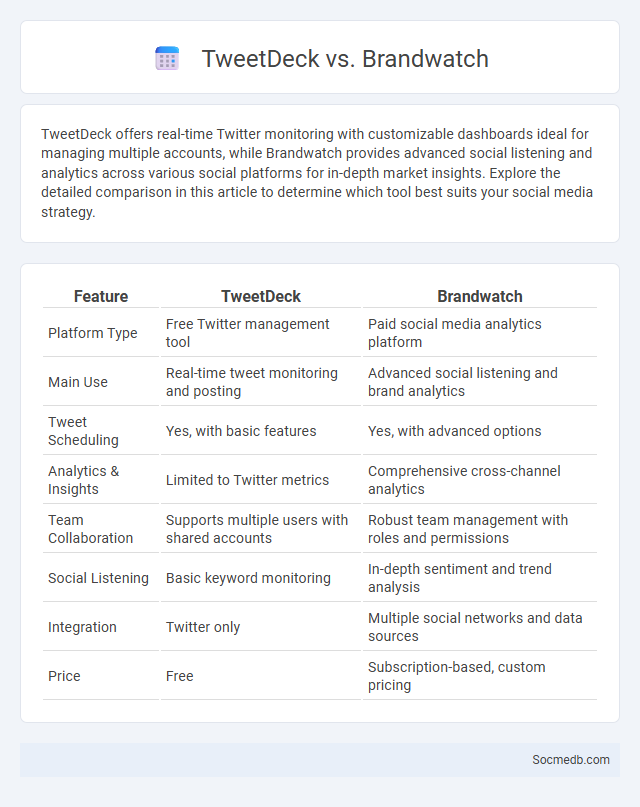
Photo illustration: TweetDeck vs Brandwatch
TweetDeck offers real-time Twitter monitoring with customizable dashboards ideal for managing multiple accounts, while Brandwatch provides advanced social listening and analytics across various social platforms for in-depth market insights. Explore the detailed comparison in this article to determine which tool best suits your social media strategy.
Table of Comparison
| Feature | TweetDeck | Brandwatch |
|---|---|---|
| Platform Type | Free Twitter management tool | Paid social media analytics platform |
| Main Use | Real-time tweet monitoring and posting | Advanced social listening and brand analytics |
| Tweet Scheduling | Yes, with basic features | Yes, with advanced options |
| Analytics & Insights | Limited to Twitter metrics | Comprehensive cross-channel analytics |
| Team Collaboration | Supports multiple users with shared accounts | Robust team management with roles and permissions |
| Social Listening | Basic keyword monitoring | In-depth sentiment and trend analysis |
| Integration | Twitter only | Multiple social networks and data sources |
| Price | Free | Subscription-based, custom pricing |
Introduction to Social Media Management Tools
Social media management tools streamline your content planning, scheduling, and analytics across platforms like Facebook, Instagram, and Twitter. These tools offer features such as real-time engagement tracking, audience insights, and automation to optimize your marketing strategy. Using the right social media management tools can significantly boost your brand's online presence and efficiency.
Key Features Overview: TweetDeck, Brandwatch, and Social Listening
TweetDeck offers real-time dashboard management to schedule, monitor, and engage with multiple Twitter accounts efficiently. Brandwatch provides powerful social media analytics and competitive intelligence by tracking brand sentiment, trends, and consumer insights across platforms. Social listening enables you to monitor online conversations, detect emerging issues, and understand audience preferences for better marketing strategies.
User Interface and Ease of Use Comparison
Social media platforms prioritize intuitive user interface designs to enhance user engagement and satisfaction, with features like simplified navigation menus and customizable feeds improving ease of use. Platforms such as Instagram and TikTok utilize visual-centric layouts and swipe gestures, enabling users to interact seamlessly with content. In contrast, Facebook combines complex functionality with scalable user interfaces, balancing feature richness and accessibility to cater to diverse user demographics.
Monitoring Capabilities: How Each Tool Tracks Conversations
Social media monitoring tools utilize advanced algorithms and keyword tracking to analyze real-time conversations across platforms like Twitter, Facebook, and Instagram. They capture sentiment, identify trending topics, and detect brand mentions to provide comprehensive insights into audience behavior. Your ability to respond promptly to customer feedback and market shifts improves significantly with these precise monitoring capabilities.
Analytics and Reporting: Insights for Better Decisions
Social media analytics and reporting provide critical insights into audience behavior, engagement patterns, and campaign performance, enabling data-driven decision-making. By leveraging tools that track metrics such as reach, impressions, click-through rates, and sentiment analysis, you can optimize content strategies and maximize ROI. Accurate reporting empowers brands to identify opportunities, refine targeting, and measure the true impact of social media efforts on business goals.
Integration with Other Platforms and Tools
Seamless integration of social media with CRM systems, email marketing platforms, and analytics tools enhances user engagement and streamlines campaign management. APIs enable cross-platform data sharing, facilitating automated content scheduling and real-time performance tracking. These integrations optimize marketing strategies by providing comprehensive insights and unified communication channels for brands.
Real-time Engagement and Scheduling Options
Social media platforms like Facebook, Instagram, and Twitter enable real-time engagement through live chats, comments, and instant reactions, fostering immediate interaction between brands and audiences. Scheduling options available on tools such as Hootsuite, Buffer, and Later allow businesses to plan and automate posts, optimizing content delivery at peak engagement times. These features collectively enhance user experience and improve marketing efficiency by balancing spontaneous communication with strategic content management.
Pricing Models and Plans Comparison
Social media platforms offer various pricing models including subscription-based plans, pay-per-click advertising, and freemium services with optional premium upgrades, tailored to different business needs and budget sizes. Popular platforms like Facebook and Instagram provide tiered advertising options with costs influenced by bidding strategies, ad placement, and audience targeting, while LinkedIn's premium plans focus on enhanced networking and lead generation features at fixed monthly rates. Understanding these pricing structures helps businesses optimize their marketing spend and maximize reach across diverse demographics.
Ideal Use Cases: Who Should Use Each Tool?
Marketers seeking to build brand awareness should utilize Instagram for its visual storytelling and high engagement rates. LinkedIn serves professionals aiming to network, share industry insights, and generate B2B leads effectively. Your choice of social media platform depends on target audience demographics and campaign goals to maximize impact and ROI.
Final Verdict: Which Tool Fits Your Needs Best?
Choosing the best social media tool depends on your specific needs, such as scheduling, analytics, or content creation. Platforms like Hootsuite excel in comprehensive management and analytics, while Canva is ideal for visual content design and creation. Evaluate your primary goals to select the tool that offers the best functionality and return on investment for your social media strategy.
 socmedb.com
socmedb.com